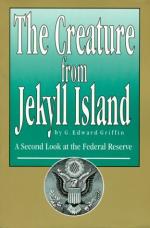
|
| Name: _________________________ | Period: ___________________ |
This quiz consists of 5 multiple choice and 5 short answer questions through Section II. A Crash Course on Money, Chapters 7-8 The Barbaric Metal; Fool's Gold.
Multiple Choice Questions
1. After analysis, what was the real nature of the S&L system?
(a) The S&L system turned out to actually be criminal.
(b) The S&L system turned out to actually be operated by international interests.
(c) The S&L system turned out to actually be a cartel within a cartel.
(d) The S&L system turned out to actually be a scam.
2. Why was gold considered the ideal metal behind a monetary system?
(a) Gold was considered the perfect metal because it was the most common of the precious metals.
(b) Gold was considered the perfect metal because it was the most sought after of the precious metals.
(c) Gold was considered the perfect metal because of its intrinsic value and scarcity throughout history.
(d) Gold was considered the perfect metal because of its value and availability.
3. What generalization did the author make about conspiracy theorists?
(a) Those who believe in conspiracy theories usually are better educated than the average person.
(b) Conspiracy theorists are generally more intelligent than the general population.
(c) Those who believe in conspiracy theories are usually more well-informed than most people.
(d) There were two kinds of people in the world--those who believed in conspiracy and those who did not.
4. What do some feel was the reason for establishing the Federal Reserve?
(a) The Federal Reserve System was concocted not to stabilize the economy and create an economy that was distributed equally among the population.
(b) The Federal Reserve System was concocted to put economic control into the hands of the people.
(c) The Federal Reserve System was concocted to stabilize the economy.
(d) The Federal Reserve System was concocted not to stabilize the economy but to put economic control into the hands of a few people who agreed not to compete with one another.
5. What occurred when coinage was weakened through lower percentages of precious metal or completing stripped of such backing?
(a) Stock market instability occurred when the coinage was debased through lower percentages of precious metal or none at all.
(b) Inflation and political turmoil occurred when the coinage was debased through lower percentages of precious metal or none at all.
(c) Deflation resulted when the coinage was debased through lower percentages of precious metal or none at all.
(d) Paper money was seen to be the superior monetary system when the coinage was debased through lower percentages of precious metal or none at all.
Short Answer Questions
1. What is the main transport of both Amtrak and Conrail?
2. The author made what sports analogy to describe the problems with the banking system?
3. What major banks failed in 1972?
4. What culture was the first to create a currency system based on gold and silver?
5. How did the government provide economic support to Lockheed Corporation in 1970?
|
This section contains 722 words (approx. 3 pages at 300 words per page) |

|




